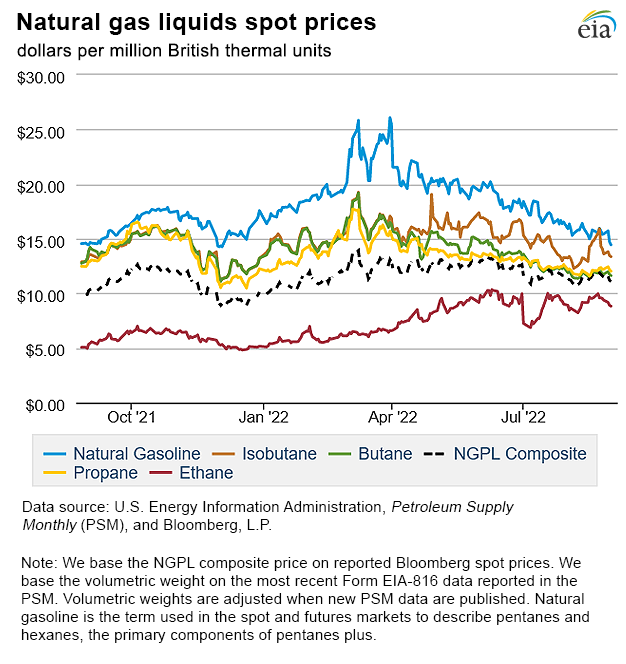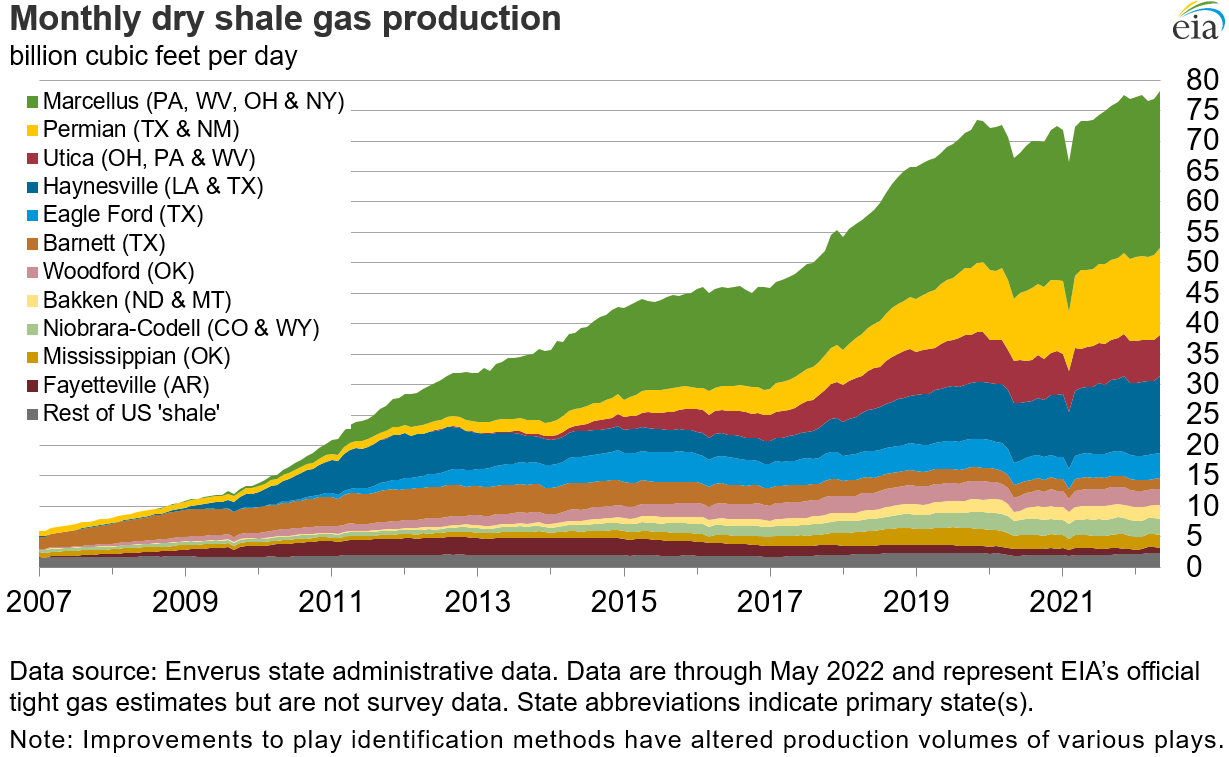In the News:
U.S. natural gas-directed rigs rise above pre-COVID levels, raising natural gas production
U.S. natural gas producers are operating more drilling rigs now compared with the beginning of the COVID-19 pandemic in early 2020. Rig counts had generally been falling through 2019, and in March 2020—around the start of the pandemic—106 natural gas-directed rigs were active, according to data from Baker Hughes Company. The number of natural gas-directed rigs decreased throughout the first half of 2020 and fell to 68 rigs by late July 2020, the fewest in Baker Hughes’s history back to 1987. Since then, the rig count has been generally increasing and reached pre-COVID levels in January 2022. The number of gas-directed rigs has averaged 160 rigs so far in August.
As drilling activity increases, we expect that dry natural gas production will rise. Our August Short-Term Energy Outlook (STEO) estimates that dry natural gas production in the United States averaged 96.4 billion cubic feet per day in (Bcf/d) in July 2022. We expect U.S. dry natural gas production to generally increase through the end of 2023, averaging about 100.3 Bcf/d in December 2023.
Most of the growth in natural gas-directed rigs has been concentrated in the Haynesville region where the rig count increased by over 50% between March 2020 and July 2022. As natural gas prices remain elevated, drilling in the Haynesville region remains economical, even though Haynesville wells are relatively deeper and more expensive to develop. In addition, the Haynesville region’s greater well productivity and its proximity to liquefied natural gas export terminals and major industrial natural gas consumers along the U.S. Gulf Coast draws operators to the region.
Rig activity in the Appalachia region has returned to similar levels to those at the beginning of the COVID-19 pandemic, at around 50 natural gas-directed rigs. Production growth in the Appalachia region over the past 10 years has been aided by improved productivity from wells drilled, pipeline buildouts, and increased takeaway capacity. However, regional transportation capacity limits are now reducing overall drilling activity in the region.
Unlike in the Appalachia region, where natural gas is produced from wells targeting natural gas, most of the natural gas production in the Permian region is associated gas produced from oil wells. As a result, producers in the Permian region respond to fluctuations in the crude oil price when planning their deployment of rigs. Crude oil prices and oil-directed rigs both generally declined in 2020 as the effects of the COVID-19 pandemic continued throughout the year. In 2021, the West Texas Intermediate (WTI) price increased steadily, averaging $68 per barrel (b) for the year compared with $39/b in 2020, and has continued to increase in 2022, averaging above $100/b in the first half of the year. Over the same period, the number of oil-directed rigs operating in the region has also been generally rising, although the rig count is still 15% lower than the early March 2020 pre-COVID count of 405 rigs.
Market Highlights:
(For the week ending Wednesday, August 31, 2022)Prices
- Henry Hub spot price: The Henry Hub spot price fell 34 cents from $9.29 per million British thermal units (MMBtu) last Wednesday to $8.95/MMBtu yesterday.
- Henry Hub futures prices: The September 2022 NYMEX contract expired Monday at $9.353/MMBtu, up 2.3 cents from last Wednesday. The October 2022 NYMEX contract price decreased to $9.127/MMBtu, down 17 cents from last Wednesday to yesterday. The price of the 12-month strip averaging October 2022 through September 2023 futures contracts climbed 4 cents to $7.394/MMBtu.
- Select regional spot prices: Natural gas spot prices were mixed this report week (Wednesday, August 24 to Wednesday, August 31), declining at most locations east of the Rocky Mountains and increasing west of the Rockies. Of the major pricing hubs, the largest week-over-week price decline was 73 cents at Algonquin Citygate and the largest increase was $6.11 at SoCal Citygate.
- The price at SoCal Citygate in Southern California increased $6.11 from $9.76/MMBtu last Wednesday to $15.87/MMBtu yesterday. The price at PG&E Citygate in Northern California rose 18 cents, up from $10.04/MMBtu last Wednesday to $10.22/MMBtu yesterday. The price at Malin, Oregon, the northern delivery point into the PG&E service territory, rose 81 cents from $8.44/MMBtu last Wednesday to $9.25/MMBtu yesterday. A massive heat wave over the western United States is building and the National Oceanic and Atmospheric Administration (NOAA) forecasts extreme heat over the Labor Day weekend. This report week, temperatures in Riverside, California, inland from Los Angeles, averaged 82°F, nearly 3°F above normal, and 2°F more than last week’s average, which resulted in 13 more cooling degree days (CDD) than last week. Yesterday, temperatures reached a daily high of 109°F and averaged 90°F, or 11°F above normal.
While increasing by less than 3%, or 0.1 billion cubic feet per day (Bcf/d), week over week, natural gas consumption in California’s electric power sector was higher at the end of the report week than at the beginning. According to data from PointLogic, consumption in the electric power sector averaged 2.8 Bcf/d from Monday to yesterday, which compares with an average 2.1 Bcf/d from last Thursday to Sunday, an increase of 36% (0.7 Bcf/d) over the course of the week.
The California Independent System Operator (CAISO) has extended its statewide Flex Alert for a second consecutive day, calling on consumers to voluntarily conserve electricity consumption on September 1 from 4:00 p.m. to 9:00 p.m. This alert follows Southern California Gas’ (SoCalGas) curtailment watch for SoCalGas and San Diego Gas & Electric (SDG&E) service territories that include Riverside, Imperial, and San Diego counties. As a result of low supplies into the Southern System, effective August 30 and until further notice, non-core customers on the Southern System may be required to reduce or stop their natural gas use and SoCalGas and SDG&E are urging customers to align natural gas usage with deliveries.
- At the Algonquin Citygate, which serves Boston-area consumers, the price went down 73 cents from $9.16/MMBtu last Wednesday to $8.43/MMBtu yesterday. At the Transco Pipeline Zone 6 trading point for New York City, the price decreased 40 cents from $8.83/MMBtu last Wednesday to $8.43/MMBtu yesterday. In the Appalachia region, the Tennessee Zone 4 Marcellus spot price decreased 34 cents from $8.46/MMBtu last Wednesday to $8.12/MMBtu yesterday, and the price at Eastern Gas South in southwest Pennsylvania fell 38 cents from $8.48/MMBtu last Wednesday to $8.10/MMBtu yesterday. Although natural gas consumption in the Northeast increased by 7% (1.1 Bcf/d) week over week, according to data from PointLogic, net natural gas flows out of the region fell by 6% (0.8 Bcf/d), contributing to lower prices. Various pipeline maintenance events on Tennessee Gas Pipeline are restricting south-bound flows out of the Northeast region.
- International futures prices: International natural gas futures prices increased this report week—reaching record-high levels—driven by natural gas supply constraints in Europe, which have grown as a result of reduced pipeline flows from Russia and a maintenance event on the Nord Stream 1 pipeline. According to Bloomberg Finance, L.P., weekly average futures prices for liquefied natural gas (LNG) cargoes in East Asia increased $5.02 to a weekly average of $64.02/MMBtu, and natural gas futures for delivery at the Title Transfer Facility (TTF) in the Netherlands, the most liquid natural gas spot market in Europe, increased $6.01 to a weekly average of $83.62/MMBtu, the highest weekly average price on record. The price at TTF rose close to $100/MMBtu earlier in the report week.
- Natural gas plant liquids prices: The natural gas plant liquids (NGPL) composite price at Mont Belvieu, Texas, fell by 39 cents/MMBtu, averaging $11.38/MMBtu for the week ending August 31. The price of ethane fell 5%, more than the natural gas price at the Houston Ship Channel, which fell 2%, leading to the ethane premium to natural gas falling by 39% week over week. The price of ethylene remained flat, widening the ethylene to ethane spread by 22%. The propane price remained relatively unchanged, while the Brent crude oil price rose 3%, resulting in the propane discount to crude oil increasing by 12%. Prices of heavier NGPLs moved in opposite directions to the crude oil price. Normal butane fell 1%, isobutane fell 9%, and natural gasoline fell 4%.
Daily spot prices by region are available on the EIA website.
Supply and Demand
- Supply: According to data from PointLogic, the average total supply of natural gas rose by 0.9% (0.9 Bcf/d) compared with the previous report week. Dry natural gas production grew by 0.7% (0.6 Bcf/d) compared with the previous report week. Average net imports from Canada increased by 5.4% (0.3 Bcf/d) from last week.
- Demand: Total U.S. consumption of natural gas rose by 3.9% (2.7 Bcf/d) compared with the previous report week, according to data from PointLogic. Natural gas consumed for power generation climbed by 5.9% (2.2 Bcf/d) week over week. Weekly average temperatures were higher than normal across much of the United States, from the West Coast to the Midcontinent, and in the Northeast. Industrial sector consumption increased by 0.6% (0.1 Bcf/d) week over week. In the residential and commercial sectors, consumption increased by 3.2% (0.3 Bcf/d). Natural gas exports to Mexico increased 2.2% (0.1 Bcf/d). Natural gas deliveries to U.S. LNG export facilities (LNG pipeline receipts) averaged 11.0 Bcf/d, 0.4% lower than last week.
Liquefied Natural Gas (LNG)
- Pipeline receipts: Natural gas deliveries to LNG export terminals in South Louisiana increased by 0.1 Bcf/d to 7.8 Bcf/d, while deliveries to terminals in South Texas decreased by 0.2 Bcf/d to 2.2 Bcf/d. Overall natural gas deliveries to U.S. LNG export terminals decreased by less than 0.1 Bcf/d and averaged 11.0 Bcf/d this week.
- Vessels departing U.S. ports: Eighteen LNG vessels (eight from Sabine Pass, three each from Cameron and Corpus Christi, two from Cove Point, and one each from Calcasieu Pass and Elba Island) with a combined LNG-carrying capacity of 67 Bcf departed the United States between August 25 and August 31, according to shipping data provided by Bloomberg Finance, L.P.
- LNG export terminals: An LNG vessel discharged a cargo of approximately 3 Bcf at the Everett LNG Facility, near Boston, Massachusetts, operated by Constellation, according to shipping data provided by Bloomberg Finance, L.P.
Rig Count
- According to Baker Hughes, for the week ending Tuesday, August 23, the natural gas rig count decreased by 1 rig from a week ago to 158 rigs. The Haynesville and the Permian each added one rig, two rigs were dropped in the Eagle Ford, and one rig was dropped in an unspecified producing region. The number of oil-directed rigs increased by 4 rigs from a week ago to 605 rigs. The Ardmore Woodford and the Permian each added two rigs, two rigs were added in unspecified producing regions, and two rigs were dropped in the Cana Woodford. The total rig count now stands at 765 rigs, which is 257 more than the same week last year.
Storage
- The net injections into storage totaled 61 Bcf for the week ending August 26, compared with the five-year (2017–2021) average net injections of 46 Bcf and last year's net injections of 21 Bcf during the same week. Working natural gas stocks totaled 2,640 Bcf, which is 338 Bcf (11%) lower than the five-year average and 228 Bcf (8%) lower than last year at this time.
- According to The Desk survey of natural gas analysts, estimates of the weekly net change to working natural gas stocks ranged from net injections of 49 Bcf to 63 Bcf, with a median estimate of 57 Bcf.
- The average rate of injections into storage is 4% lower than the five-year average so far in the refill season (April through October). If the rate of injections into storage matched the five-year average of 10.1 Bcf/d for the remainder of the refill season, the total inventory would be 3,307 Bcf on October 31, which is 338 Bcf lower than the five-year average of 3,645 Bcf for that time of year.
See also:
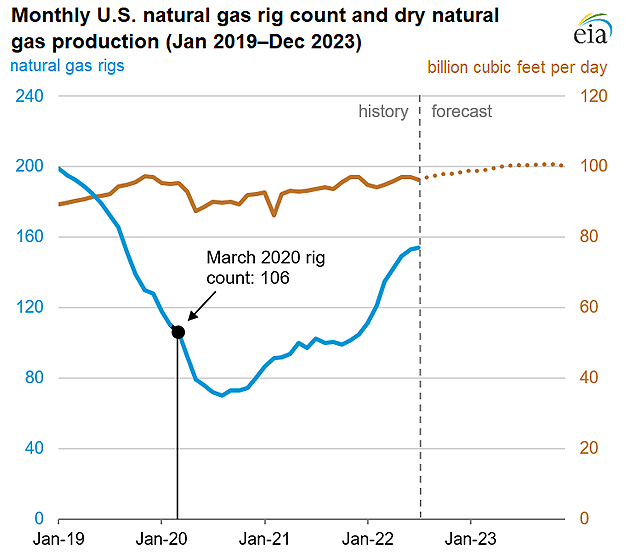 Data source: U.S. Energy Information Administration, Short-Term Energy Outlook (production), and Baker Hughes Company (rig count)
Data source: U.S. Energy Information Administration, Short-Term Energy Outlook (production), and Baker Hughes Company (rig count)
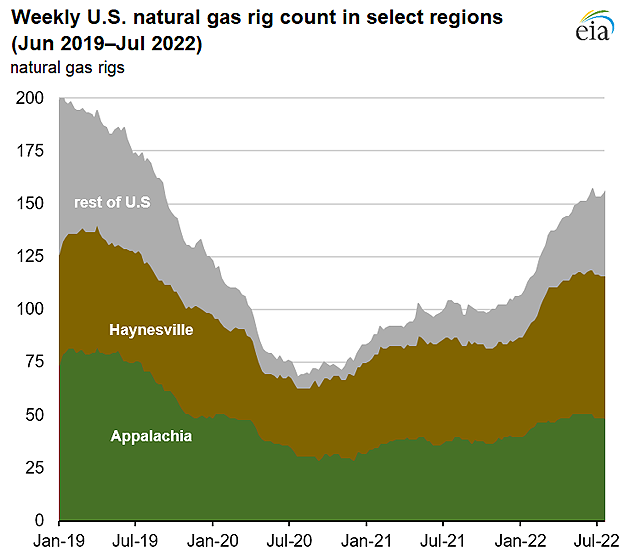 Data source: Baker Hughes Company
Data source: Baker Hughes Company
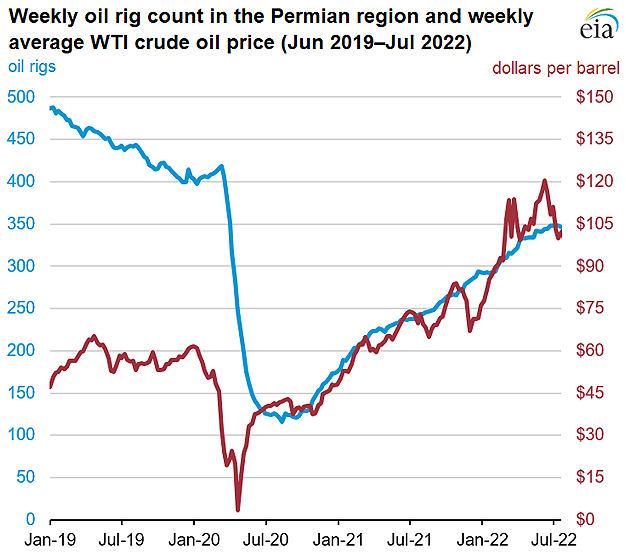 Data source: Baker Hughes Company
Data source: Baker Hughes Company
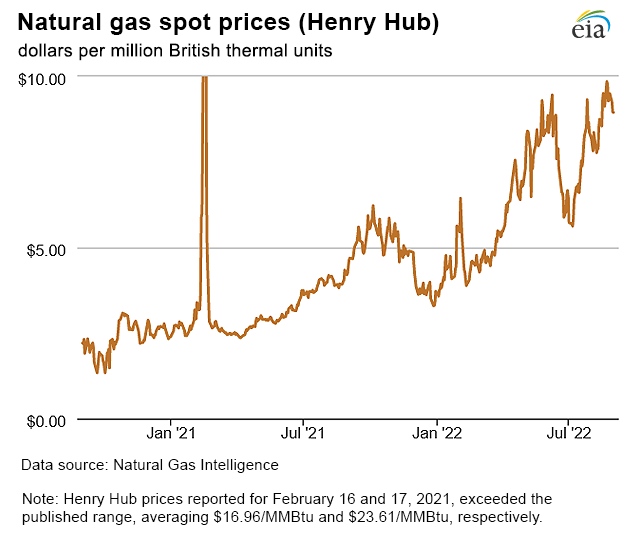
| Spot Prices ($/MMBtu) | Thu, 25-Aug |
Fri, 26-Aug |
Mon, 29-Aug |
Tue, 30-Aug |
Wed, 31-Aug |
|---|---|---|---|---|---|
| Henry Hub | 9.33 | 9.50 | 9.25 | 8.96 | 8.95 |
| New York | 8.66 | 8.81 | 9.02 | 8.59 | 8.43 |
| Chicago | 8.76 | 8.74 | 8.83 | 8.51 | 8.53 |
| Cal. Comp. Avg.* | 9.41 | 9.26 | 9.93 | 10.33 | 10.74 |
| Futures ($/MMBtu) | |||||
| September Contract | 9.375 | 9.296 | 9.353 | Expired | Expired |
| October Contract | 9.344 | 9.269 | 9.336 | 9.042 | 9.127 |
| November Contract | 9.419 | 9.332 | 9.400 | 9.103 | 9.189 |
| Data source: Natural Gas Intelligence and CME Group as compiled by Bloomberg, L.P. | |||||
| *Avg. of NGI's reported prices for: Malin, PG&E Citygate, and Southern California Border Avg. | |||||
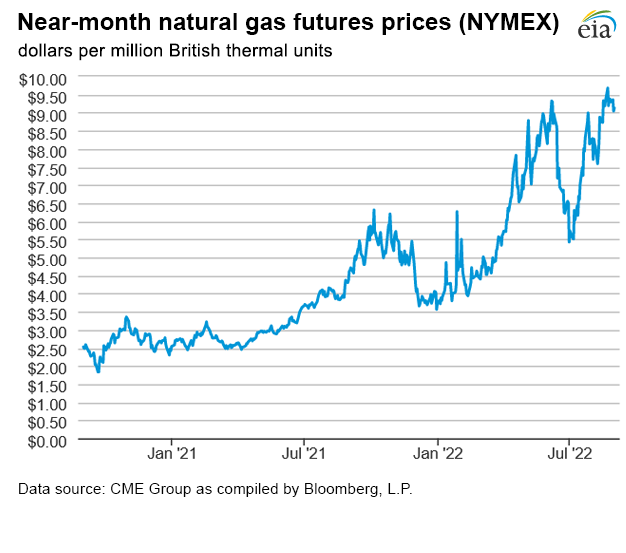
| U.S. natural gas supply - Gas Week: (8/25/22 - 8/31/22) | |||
|---|---|---|---|
Average daily values (billion cubic feet) |
|||
this week |
last week |
last year |
|
| Marketed production | 110.4 |
109.7 |
105.5 |
| Dry production | 97.6 |
97.0 |
93.3 |
| Net Canada imports | 5.6 |
5.3 |
5.1 |
| LNG pipeline deliveries | 0.1 |
0.1 |
0.1 |
| Total supply | 103.3 |
102.4 |
98.5 |
|
Data source: PointLogic | |||
| U.S. natural gas consumption - Gas Week: (8/25/22 - 8/31/22) | |||
|---|---|---|---|
Average daily values (billion cubic feet) |
|||
this week |
last week |
last year |
|
| U.S. consumption | 70.9 |
68.3 |
72.0 |
| Power | 40.5 |
38.3 |
42.6 |
| Industrial | 21.3 |
21.2 |
21.1 |
| Residential/commercial | 9.1 |
8.8 |
8.3 |
| Mexico exports | 5.7 |
5.6 |
6.3 |
| Pipeline fuel use/losses | 6.7 |
6.6 |
6.4 |
| LNG pipeline receipts | 11.0 |
11.1 |
10.6 |
| Total demand | 94.4 |
91.5 |
95.4 |
|
Data source: PointLogic | |||
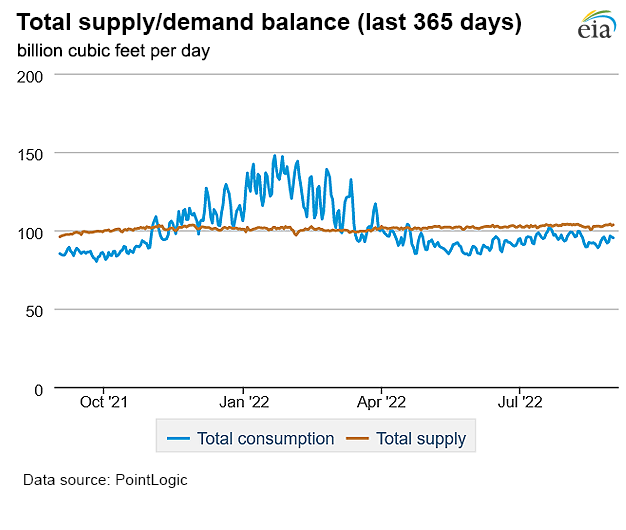
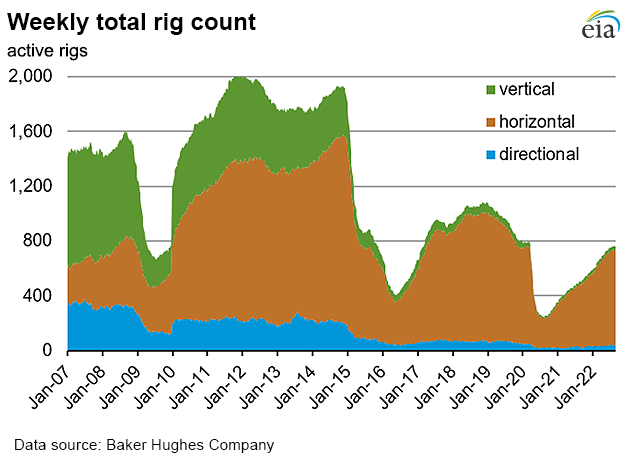
| Rigs | |||
|---|---|---|---|
Tue, August 23, 2022 |
Change from |
||
last week |
last year |
||
| Oil rigs | 605 |
0.7% |
47.6% |
| Natural gas rigs | 158 |
-0.6% |
62.9% |
| Note: Excludes any miscellaneous rigs | |||
| Rig numbers by type | |||
|---|---|---|---|
Tue, August 23, 2022 |
Change from |
||
last week |
last year |
||
| Vertical | 31 |
6.9% |
47.6% |
| Horizontal | 694 |
0.0% |
51.2% |
| Directional | 40 |
2.6% |
42.9% |
| Data source: Baker Hughes Company | |||
| Working gas in underground storage | ||||
|---|---|---|---|---|
Stocks billion cubic feet (Bcf) |
||||
| Region | 2022-08-26 |
2022-08-19 |
change |
|
| East | 614 |
598 |
16 |
|
| Midwest | 747 |
714 |
33 |
|
| Mountain | 157 |
153 |
4 |
|
| Pacific | 241 |
243 |
-2 |
|
| South Central | 881 |
871 |
10 |
|
| Total | 2,640 |
2,579 |
61 |
|
| Data source: U.S. Energy Information Administration Form EIA-912, Weekly Underground Natural Gas Storage Report | ||||
| Working gas in underground storage | |||||
|---|---|---|---|---|---|
Historical comparisons |
|||||
Year ago (8/26/21) |
5-year average (2017-2021) |
||||
| Region | Stocks (Bcf) |
% change |
Stocks (Bcf) |
% change |
|
| East | 676 |
-9.2 |
711 |
-13.6 |
|
| Midwest | 809 |
-7.7 |
811 |
-7.9 |
|
| Mountain | 190 |
-17.4 |
188 |
-16.5 |
|
| Pacific | 243 |
-0.8 |
273 |
-11.7 |
|
| South Central | 951 |
-7.4 |
995 |
-11.5 |
|
| Total | 2,868 |
-7.9 |
2,978 |
-11.3 |
|
| Data source: U.S. Energy Information Administration Form EIA-912, Weekly Underground Natural Gas Storage Report | |||||
| Temperature – heating & cooling degree days (week ending Aug 25) | ||||||||
|---|---|---|---|---|---|---|---|---|
HDDs |
CDDs |
|||||||
| Region | Current total |
Deviation from normal |
Deviation from last year |
Current total |
Deviation from normal |
Deviation from last year |
||
| New England | 0 |
-5 |
0 |
57 |
30 |
-14 |
||
| Middle Atlantic | 0 |
-3 |
0 |
66 |
26 |
-15 |
||
| E N Central | 1 |
-5 |
1 |
40 |
1 |
-40 |
||
| W N Central | 1 |
-7 |
-1 |
49 |
-3 |
-28 |
||
| South Atlantic | 0 |
-1 |
0 |
88 |
3 |
-21 |
||
| E S Central | 0 |
0 |
0 |
75 |
-6 |
-29 |
||
| W S Central | 0 |
0 |
0 |
103 |
-13 |
-30 |
||
| Mountain | 1 |
-9 |
-6 |
62 |
-4 |
7 |
||
| Pacific | 0 |
-5 |
-4 |
66 |
24 |
42 |
||
| United States | 1 |
-4 |
-1 |
69 |
7 |
-13 |
||
|
Data source: National Oceanic and Atmospheric Administration Note: HDDs=heating degree days; CDDs=cooling degree days | ||||||||
Average temperature (°F)
7-day mean ending Aug 25, 2022
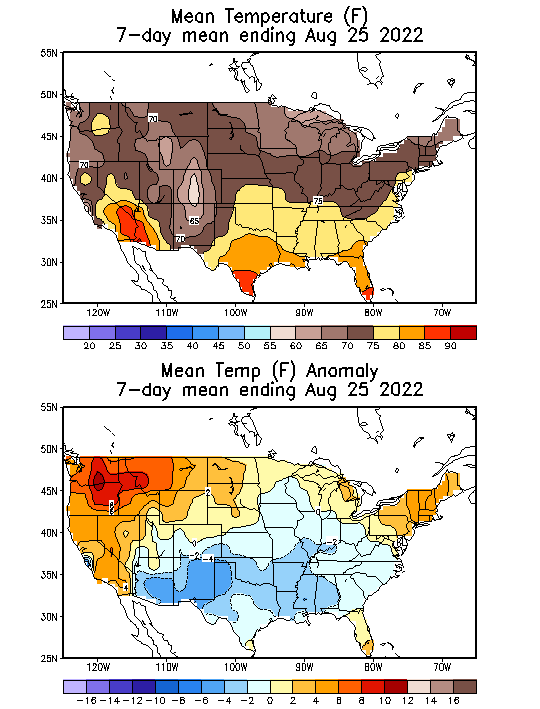
Data source: National Oceanic and Atmospheric Administration
Deviation between average and normal temperature (°F)
7-day mean ending Aug 25, 2022

Data source: National Oceanic and Atmospheric Administration

